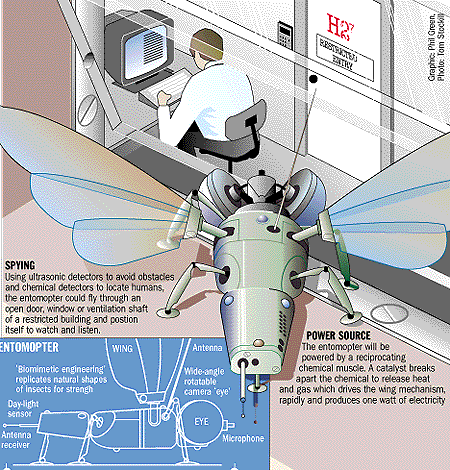- ROBOT "insects" capable of flying military spy missions inside
buildings are being developed by a Cambridge University scientist. But
the technology - which could revolutionise the nature of flight - is set
to be lost to Britain. It is being snapped up by the United States Department
of Defence after the British military said it was not interested.
-
- Charles Ellington, who has spent many
years researching the aerodynamics of insects, this week is expected to
receive part of a £1.6 million contract to produce a robot micro
aircraft, about the size of a hand and with a 3ins or 4ins wingspan, that
will fly surveillance missions inside buildings. He is currently working
on a 3ft wingspan model, based on a hawk moth.
-
- The craft, called an entomopter, will
use a chemical engine to flap wings like a moth, crawl about, and flit
from in-trays to out-trays taking photographs and recording conversations
for transmission to satellites.
-
- Mr Ellington's breakthrough in understanding
insect flight will make flapping-wing flight by an aircraft possible for
the first time. American officials believe his work offers huge opportunities
for development - nothing in creation has been developed with fixed wings
and power thrust, just flapping wings.
-
- "Technically, this is a very exciting
development," said John Anderson, an adviser with the Smithsonian
Air and Space Museum in Washington. "Micro air vehicles with flapping
wings use different aerodynamics from birds, and I think we will continue
to use fixed-wings for manned flight. But this will fill in one significant
corner of the flight spectrum.
-
- "If it comes here rather than to
Britain, well, I must say I've always been very impressed with the pioneering
work Britain did in aviation - swing-wing flight and vertical take-off."
-
-

-
-
- Sir Barnes Wallis, the inventor of the
Dambusters' bouncing bomb, designed the first variable-geometry swing-wing
aircraft, which would have become the TSR-2 if the government had not cancelled
it in 1965. Instead, the Americans developed it as the F-111 bomber. As
for vertical flight, Britain did produce the Harrier but is now a junior
partner in American-driven developments of the next-generation Joint Strike
Fighter. The Americans are now well ahead with many aerospace ideas, particularly
in unmanned air vehicles.
-
- Mr Ellington, an American who has dual
citizenship, said: "I did approach the Defence Research Agency at
Farnborough six or seven months ago, but they just seemed to drop it. They
weren't interested. Darpa (the Defence Advanced Research Projects Agency)
in America was much more interested."
-
- He now keeps his proposal under lock
and key because the Pentagon is concerned about the security of the research.
"I'm not allowed to show it to anyone here," he said. "I
would hope this doesn't mean completely shutting out Britain, or anyone
else. It's a shame there isn't more interest from the government here."
-
- A spokesman for the British agency said
that Mr Ellington did approach it but its scientists were not doing any
work in that area, and had no funding for it. The proposal was passed to
the Royal College of Military Science at Shrivenham, Oxon. Mr Ellington
said he was not told of that transfer and has heard nothing from Shrivenham.
-
- Instead, he and the nine-strong team
from his laboratory at Cambridge University's Department of Zoology will
join Robert Michelson, the principal research engineer at Georgia Tech
Research Institute in Atlanta, to produce a working entomopter. The three-year
Darpa contract calls for them to build a controllable, stable, flapping
machine.
-
- Since batteries are too heavy and combustion
engines are too big their entomopter is to be powered with Mr Michelson's
reciprocating chemical muscle.
-
- He describes this as a catalyst that
breaks apart a chemical to release heat and gas that drives the wings rapidly
and releases up to one watt of electricity. Micro-electronics, controls
and sensor systems will then be added.
-
- When placed by a special operations team
or remote controlled aircraft, the entomopter would fly through an open
door, window or ventilation shaft of a building. Its flapping wings would
make it much quieter than helicopter rotors. It would use ultrasonic detectors
to avoid obstacles and chemical detectors to locate humans at which to
direct sound recorders.
|